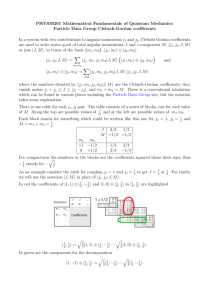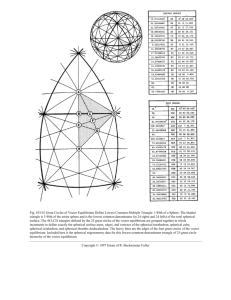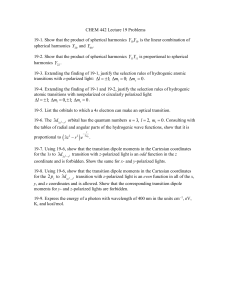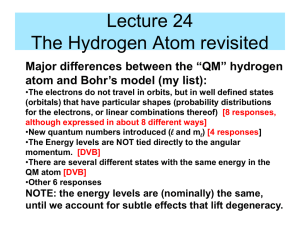Clebsch-Gordon coefficients and the tensor spherical
advertisement
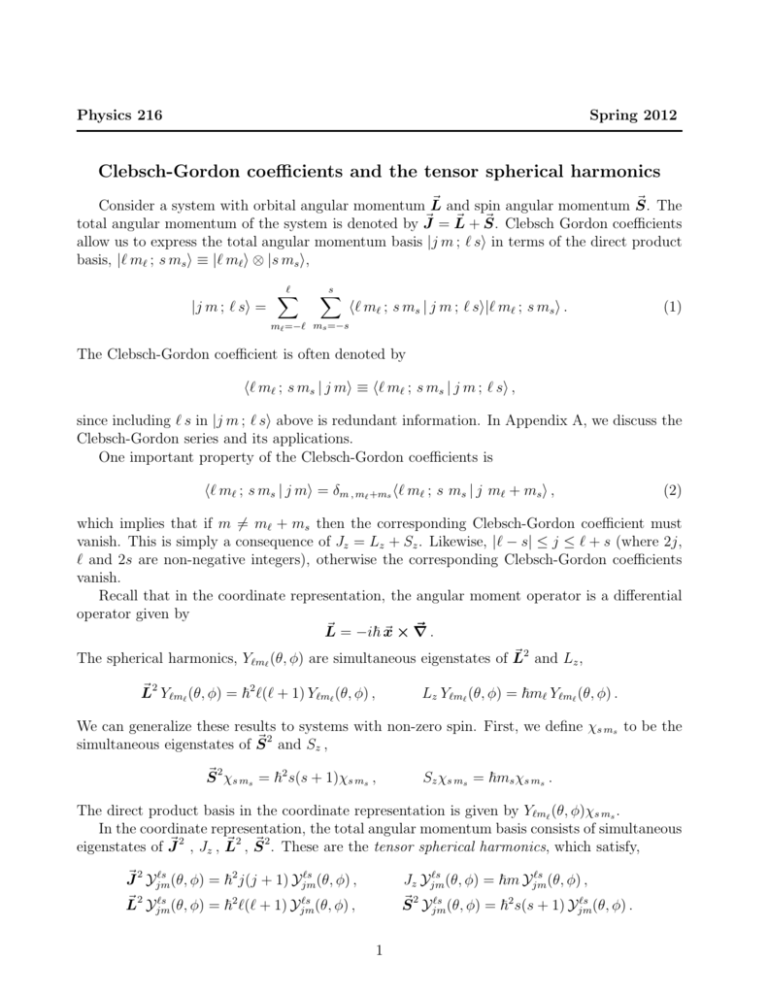
Physics 216
Spring 2012
Clebsch-Gordon coefficients and the tensor spherical harmonics
~ and spin angular momentum S.
~ The
Consider a system with orbital angular momentum L
~
~
~
total angular momentum of the system is denoted by J = L + S. Clebsch Gordon coefficients
allow us to express the total angular momentum basis |j m ; ℓ si in terms of the direct product
basis, |ℓ mℓ ; s ms i ≡ |ℓ mℓ i ⊗ |s ms i,
|j m ; ℓ si =
ℓ
X
s
X
mℓ =−ℓ ms =−s
hℓ mℓ ; s ms | j m ; ℓ si|ℓ mℓ ; s ms i .
(1)
The Clebsch-Gordon coefficient is often denoted by
hℓ mℓ ; s ms | j mi ≡ hℓ mℓ ; s ms | j m ; ℓ si ,
since including ℓ s in |j m ; ℓ si above is redundant information. In Appendix A, we discuss the
Clebsch-Gordon series and its applications.
One important property of the Clebsch-Gordon coefficients is
hℓ mℓ ; s ms | j mi = δm , mℓ +ms hℓ mℓ ; s ms | j mℓ + ms i ,
(2)
which implies that if m 6= mℓ + ms then the corresponding Clebsch-Gordon coefficient must
vanish. This is simply a consequence of Jz = Lz + Sz . Likewise, |ℓ − s| ≤ j ≤ ℓ + s (where 2j,
ℓ and 2s are non-negative integers), otherwise the corresponding Clebsch-Gordon coefficients
vanish.
Recall that in the coordinate representation, the angular moment operator is a differential
operator given by
~ = −i~ x
~ .
~ ×∇
L
~ 2 and Lz ,
The spherical harmonics, Yℓm (θ, φ) are simultaneous eigenstates of L
ℓ
~ 2 Yℓm (θ, φ) = ~2 ℓ(ℓ + 1) Yℓm (θ, φ) ,
L
ℓ
ℓ
Lz Yℓmℓ (θ, φ) = ~mℓ Yℓmℓ (θ, φ) .
We can generalize these results to systems with non-zero spin. First, we define χs ms to be the
~ 2 and Sz ,
simultaneous eigenstates of S
~ 2 χs ms = ~2 s(s + 1)χs ms ,
S
Sz χs ms = ~ms χs ms .
The direct product basis in the coordinate representation is given by Yℓmℓ (θ, φ)χs ms .
In the coordinate representation, the total angular momentum basis consists of simultaneous
~ 2 , Jz , L
~2, S
~ 2 . These are the tensor spherical harmonics, which satisfy,
eigenstates of J
~ 2 Y ℓs (θ, φ) = ~2 j(j + 1) Y ℓs (θ, φ) ,
J
jm
jm
2 ℓs
2
ℓs
~
L Y (θ, φ) = ~ ℓ(ℓ + 1) Y (θ, φ) ,
jm
ℓs
ℓs
Jz Yjm
(θ, φ) = ~m Yjm
(θ, φ) ,
2
~ Y ℓs (θ, φ) = ~2 s(s + 1) Y ℓs (θ, φ) .
S
jm
jm
1
jm
As a consequence of eq. (1), the tensor spherical harmonics are defined by
ℓs
Yjm
(θ, φ)
ℓ
X
=
s
X
hℓ mℓ ; s ms | j miYℓmℓ (θ, φ)χs ms
mℓ =−ℓ ms =−s
=
s
X
hℓ , m − ms ; s ms | j miYℓ , m−ms (θ, φ)χs ms ,
(3)
ms =−s
where the second line follows from the first line above since the Clebsch-Gordon coefficient
above vanishes unless m = mℓ + ms .
The general expressions for the Clebsch-Gordon coefficients in terms of j, mℓ , ℓ, s and ms
are very complicated to write down. Nevertheless, the explicit expressions in the simplest cases
of s = 1/2 and s = 1 are manageable. Thus, we shall exhibit these two special cases below.
For spin s = 1/2, the possible values of j are j = ℓ + 12 and ℓ − 21 , for ℓ = 1, 2, 3, . . . . If ℓ = 0
then only j = 12 is possible (and the last row of Table 1 should be omitted). The corresponding
table of Clebsch-Gordon coefficients is exhibited in Table 1.
Table 1: the Clebsch-Gordon coefficients, hℓ m − ms ;
ms =
1
2
ℓ+m+
2ℓ + 1
1
2
j
ℓ+
1
2
ℓ−
1
2
ℓ−m+
−
2ℓ + 1
1
2
ms | jmi.
ms = − 12
1/2
ℓ−m+
2ℓ + 1
1 1/2
2
1 1/2
2
ℓ+m+
2ℓ + 1
1 1/2
2
Comparing with eq. (3), the entries in Table 1 are equivalent to the following result:
q
E q
E
E
1
1 1 1
1 1
1
1
1
1
.
± ℓ + 2 ± m ℓ m − 2 ; 2 2 + ℓ + 2 ∓ m ℓ m + 2 ; 2 − 2
j = ℓ ± 2 m = √
2ℓ + 1
We can represent | 12 21 i = ( 10 ) and | 12 − 12 i = ( 01 ). Then in the coordinate representation,
the spin spherical harmonics are given by
q
1
1
ℓ
±
m
+
Y
±
(θ,
φ)
ℓ,m− 2
2
1
ℓ 21
1
(4)
Yj=ℓ±
.
1 , m (θ, φ) ≡ hθ φ | j = ℓ ± 2 , mi = √
q
2
2ℓ + 1
1
ℓ ∓ m + 2 Yℓ,m+ 21 (θ, φ)
If ℓ = 0, there is only one spin spherical harmonic,
0
1
Yj=2 1 , m (θ, φ) ≡ hθ φ | j = 12 , mi = √
2
2
q
1
2
+ m Y0,m− 21 (θ, φ)
2
− m Y0,m+ 21 (θ, φ)
1
q
2ℓ + 1
1
.
(5)
Note that when m = 12 the lower component of eq. (5) vanishes and when m = − 21 the upper
component of √
eq. (5) vanishes. In both cases, the non-vanishing component is proportional to
Y00 (θ, φ) = 1/ 4π.
For spin s = 1, the possible values of j are j = ℓ + 1 , ℓ , ℓ − 1 for ℓ = 1, 2, 3, . . .. If ℓ = 0
then only j = 1 is possible (and the last two rows exhibited in Table 2 should be omitted). The
corresponding table of Clebsch-Gordon coefficients is exhibited in Table 2.
Table 2: the Clebsch-Gordon coefficients, hℓ m − ms ; 1 ms | jmi.
j
ℓ+1
ℓ
ℓ−1
ms = 1
(ℓ + m)(ℓ + m + 1)
(2ℓ + 1)(2ℓ + 2)
ms = 0
1/2
(ℓ − m + 1)(ℓ + m)
−
2ℓ(ℓ + 1)
(ℓ − m)(ℓ − m + 1)
2ℓ(2ℓ + 1)
(ℓ − m + 1)(ℓ + m + 1)
(ℓ + 1)(2ℓ + 1)
1/2
1/2
ms = −1
m
p
ℓ(ℓ + 1)
(ℓ − m)(ℓ + m)
−
ℓ(2ℓ + 1)
1/2
(ℓ − m)(ℓ − m + 1)
(2ℓ + 1)(2ℓ + 2)
1/2
1/2
(ℓ − m)(ℓ + m + 1)
2ℓ(ℓ + 1)
(ℓ + m)(ℓ + m + 1)
2ℓ(2ℓ + 1)
1/2
1/2
0
0
1
Using a spherical basis, we can represent |1 1i = 0 , |1 0i = 1 and |1 − 1i = 0 .
1
0
0
With respect to this basis, we can explicitly write out the three vector spherical harmonics,
ℓ1
ℓ1
Yj=ℓ±1
, m (θ, φ) and Yj=ℓ , m (θ, φ). For example, if ℓ 6= 0 then,
1/2
(ℓ − m + 1)(ℓ + m)
Yℓ,m−1 (θ, φ)
−
2ℓ(ℓ + 1)
m
ℓ1
.
p
Yℓm (θ, φ)
Yj=ℓ , m (θ, φ) =
ℓ(ℓ + 1)
1/2
(ℓ + m + 1)(ℓ − m)
Yℓ,m−1 (θ, φ)
2ℓ(ℓ + 1)
The other two vector spherical harmonics can be written out in a similar fashion. If ℓ = 0 then
ℓ1
Yj=ℓ+1
, m (θ, φ) is the only surviving vector spherical harmonic.
It is instructive to work in a Cartesian basis, where the χ1,ms are eigenvectors of S3 , and
~ where (Sk )ij = −iǫijk . In particular,
the spin-1 spin matrices are given by ~S,
0 −i
0
0
0 .
S3 = i
0
0
0
and S3 χ1,ms = ms χ1,ms . This yields the orthonormal eigenvectors,
∓1
0
1
χ1,±1 = √ −i ,
χ1,0 = 0 .
2
0
1
3
(6)
where the arbitrary overall phase factors are conventionally chosen to be unity. As an example,
in the Cartesian basis,
[(ℓ − m + 1)(ℓ + m)]1/2 Yℓ,m−1 (θ, φ) + [(ℓ + m + 1)(ℓ − m)]1/2 Yℓ,m+1 (θ, φ)
1
ℓ1
1/2
1/2
Yj=ℓ , m (θ, φ) = p
i [(ℓ − m + 1)(ℓ + m)] Yℓ,m−1(θ, φ) − i [(ℓ + m + 1)(ℓ − m)] Yℓ,m+1 (θ, φ) .
2 ℓ(ℓ + 1)
2mYℓm (θ, φ)
(7)
This is a vector
with
respect
to
the
basis
{x̂
,
ŷ
,
ẑ}.
It
is
convenient
to
rewrite
eq.
(7)
in
terms
of the basis r̂ , θ̂ , φ̂ using
x̂ = r̂ sin θ cos φ + θ̂ cos θ cos φ − φ̂ sin φ ,
ŷ = r̂ sin θ sin φ + θ̂ cos θ sin φ + φ̂ cos φ ,
ẑ = r̂ cos θ − θ̂ sin θ .
ℓ1
We can then greatly simplify the resulting expression for Yj=ℓ
, m (θ, φ) by employing the recursion
relation,
−2m cos θ Yℓm (θ, φ) = sin θ [(ℓ + m + 1)(ℓ − m)]1/2 e−iφ Yℓ,m+1 (θ, φ)
1/2
+ [(ℓ − m + 1)(ℓ + m)]
iφ
e Yℓ,m−1(θ, φ) ,
and the following two differential relations,
∂
Yℓm (θ, φ) = imYℓm (θ, φ) ,
∂φ
∂
Yℓm (θ, φ) = 12 [(ℓ + m + 1)(ℓ − m)]1/2 e−iφ Yℓ,m+1(θ, φ)
∂θ
− 12 [(ℓ − m + 1)(ℓ + m)]1/2 eiφ Yℓ,m−1 (θ, φ) .
Following a straightforward but tedious computation, the end result is:
"
#
θ̂ ∂
i
∂
ℓ1
Yj=ℓ
Yℓm (θ, φ) − φ̂
Yℓm (θ, φ) .
, m (θ, φ) = p
∂θ
ℓ(ℓ + 1) sin θ ∂φ
~ expressed in the r̂ , θ̂ , φ̂ basis,
At this point, one should recognize the differential operator L
#
"
θ̂
∂
∂
~ = −i~ x
~ = i~
~ ×∇
.
L
− φ̂
sin θ ∂φ
∂θ
Hence, we end up with
ℓ1
Yj=ℓ
, m (θ, φ) = p
1
~2 ℓ(ℓ
+ 1)
4
~ Yℓm (θ, φ) ,
L
for ℓ 6= 0 .
(8)
This is the vector spherical harmonic,
~ ℓm (θ, φ) = p −i
~ Yℓm (θ, φ) ,
~ ×∇
x
X
ℓ(ℓ + 1)
employed by J.D. Jackson, Classical Electrodynamics, 3rd Edition (John Wiley & Sons, Inc.,
New York, 1999).
Using the same methods, one can derive the following expressions for the other two vector
spherical harmonics,
h
i
−1
ℓ1
~
Yj=ℓ−1 , m (θ, φ) = p
(j + 1)n̂ − r ∇ Yjm (θ, φ) ,
for ℓ 6= 0 ,
(9)
(j + 1)(2j + 1)
ℓ1
Yj=ℓ+1
, m (θ, φ) = p
1
j(2j + 1)
h
i
~ Yjm (θ, φ) ,
j n̂ + r ∇
(10)
~ = r~
where x
n and n̂ ≡ r̂. That is, the three independent normalized vector spherical harmonics
can be chosen as:1
r
−ir
~
~
p
n̂ × ∇ Yjm (θ, φ) , p
∇ Yjm(θ, φ) , n̂ Yjm (θ, φ) .
(11)
j(j + 1)
j(j + 1)
~ Yjm (θ, φ) = ∂Yjm (θ, φ)/∂r = 0. Hence, it follows that the first two vector
Note that n̂ · ∇
spherical harmonics of eq. (11) are transverse (i.e., perpendicular to n̂), whereas the third
vector spherical harmonic in eq. (11) is longitudinal (i.e., parallel to n̂). This is convenient for
the multipole expansion of the transverse electric and magnetic radiation fields, where only the
~ Yjm(θ, φ) and n̂ Yjm (θ, φ)
first two vector spherical harmonics of eq. (11) appear. However, r ∇
~ 2 since they consist of linear combinations of states with ℓ = j ± 1
are not eigenstates of L
[which can be explicitly derived by inverting eqs. (9) and (10)].
The algebraic steps involved in establishing eqs. (8)–(10) are straightforward but tedious.
A more streamlined approach to the derivation of these results is given in Appendix B.
Appendix A: The Clebsch-Gordon series and some applications
The Clebsch-Gordon coefficients form a unitary matrix. It is standard practice to employ a
phase convention in defining the Clebsch-Gordon coefficients (called the Condon-Shortly phase
convention) such that all the Clebsch-Gordon coefficients are real. In particular,
hj1 m1 ; j2 m2 | jmi = hjm | j1 m1 ; j2 m2 i .
~ Yjm (θ, φ) = −r[n̂(n̂ · ∇)
~ − ∇]Y
~ jm (θ, φ) = −r n̂ × (n̂ × ∇)Y
~ jm (θ, φ),
It is often convenient to rewrite r ∇
~ Yjm (θ, φ) = ∂Yjm (θ, φ)/∂r = 0 as noted above. This alternative form is often used for the second
since n̂ · ∇
vector spherical harmonic of eq. (11).
1
5
In this convention, the Clebsch-Gordon coefficients form an orthogonal matrix and therefore
satisfy orthogonality relations,
X
hj1 m1 ; j2 m2 | j mihj1 m′1 ; j2 m′2 | j mi = δm1 ,m′1 δm2 ,m′2 ,
(12)
j,m
X
m1 ,m2
hj1 m1 ; j2 m2 | j mihj1 m1 ; j2 m2 | j ′ m′ i = δj j ′ δm,m′ ∆(j1 j2 j) ,
(13)
where j1 , j2 and j are non-negative integers or half-integers and
(
1,
if |j1 − j2 | ≤ j ≤ j1 + j2 ,
∆(j1 j2 j) =
0,
otherwise.
(14)
~ =J
~1 +J
~ 2 . Clebsch-Gordon coefConsider a system whose total angular momentum is J
ficients provide the connection between the total angular momentum basis |j m ; j1 j2 i and the
direct product basis, |j1 m1 ; j2 m1 i ≡ |j1 m1 i ⊗ |j2 m2 i,
|j mi =
j1
X
j2
X
m1 =−j1 m2 =−j2
hj1 m1 ; j2 m2 | j mi|j1 m1 ; j2 m2 i .
(15)
The unitary operator that (actively) rotates states by an angle θ about an axis n̂ is
~
U[R(n̂, θ)] = exp −iθn̂ · J /~ .
~ commutes
Applying U[R(n̂, θ)] to the state |j mi does not change the value of j since n̂ · J
2
~
with J . Then, inserting a complete set of states, one obtains
X
X (j)
~ /~)|j m′ i =
U[R(n̂, θ)]|j m′ i =
|j mihj m| exp(−iθn̂ · J
Dmm′ (R)|j mi ,
m
hj m′ |U[R(n̂, θ)] =
X
m
m
~ /~)|j m′ ihj m| =
hj m| exp(−iθn̂ · J
X
m
(j)
hj m| Dmm′ (R) ,
which defines the (2j + 1) × (2j + 1) unitary matrix D (j) (R) that represents the rotation R.
Consider the matrix element hj1 m1 ; j2 m2 |U[R(n̂, θ)]|j mi. We can compute this in two
different ways by letting the operator U[R(n̂, θ)] act either to the right or to the left.
X (j)
hj1 m1 ; j2 m2 |U[R(n̂, θ)]|j m′ i =
Dqm′ (R)hj1 m1 ; j2 m2 | j qi ,
q
hj1 m1 ; j2 m2 |U[R(n̂, θ)]|j m′ i =
X
m′1 ,m′2
(j )
(j )
hj1 m′1 ; j2 m′2 | j m′ i Dm11 m′ (R) Dm22 m′ (R) .
1
2
Equating these two expressions yields
X (j)
X
(j )
(j )
hj1 m′1 ; j2 m′2 | j m′ i Dm11 m′ (R) Dm22 m′ (R) .
Dqm′ (R)hj1 m1 ; j2 m2 | j qi =
1
q
m′1 ,m′2
6
2
Multiplying this result by hj1 q1 ; j2 q2 | j m′ i and summing over j and m′ using the orthogonality
relation given in eq. (12), we end up with
X
(j)
(j1 )
(j2 )
Dm
(R)
D
(R)
=
hj1 m1 ; j2 m2 | j qihj1 q1 ; j2 q2 | j m′ iDqm′ (R) ,
m2 q2
1 q1
q,j,m′
which is called the Clebsch-Gordon series. The sum over q and m′ can be performed immediately
since the Clebsch-Gordon coefficients above vanish unless q = m1 + m2 and m′ = q1 + q2 ,
respectively. After relabeling, we are left with
X
(j )
(j )
(j)
Dm11 m′ (R) Dm22 m′ (R) =
hj1 m1 ; j2 m2 | j , m1 +m2 i hj1 m′1 ; j2 m′2 | j , m′1 +m′2 i Dm1 +m2 ,m′ +m′ (R) .
1
1
2
2
j
(16)
For non-negative integer ℓ, one can prove that
r
(ℓ)
Dm 0 (α, β, γ) =
4π
Y ∗ (β, α) ,
2ℓ + 1 ℓm
(17)
where (α, β, γ) are the Euler angles that specify the rotation R. Thus, setting q1 = q2 = 0 and
taking integer values j1 = ℓ1 and j2 = ℓ2 in eq. (16), it follows that
s
X (2ℓ + 1)(2ℓ + 1)
1
2
hℓ1 m1 ; ℓ2 m2 | ℓ mihℓ1 0 ; ℓ2 0 | ℓ 0i Yℓm(n̂) . (18)
Yℓ1 m1 (n̂) Yℓ2 m2 (n̂) =
4π(2ℓ + 1)
ℓ,m
To establish eq. (17), recall that the Euler angle representation of the rotation R, described
in the handout, Three-Dimensional Rotation Matrices, is given by
R(n̂, θ) = R(ẑ, α)R(ŷ, β)R(ẑ, γ) .
(19)
Likewise,2
(j)
(j)
′
(j)
Dmm′ (R) ≡ Dmm′ (α, β, γ) = hj m| e−iαJz /~ e−iβJy /~ e−iγJz /~ |jm′ i = e−i(αm+γm ) dmm′ (β) , (20)
where d(j) (β) ≡ hj m| e−iβJy /~ |jm′ i .
(j)
A relation between the Dmm′ (R) and the spherical harmonics can be determined as follows.
First, note that U[R(n̂, θ)]|~xi = |R~xi, where (R~x)i ≡ Rij xj (with an implicit sum over the repeated index j). Since U[R1 ]U[R2 ] = U[R1 R2 ] it follows that U † [R] = U −1 [R] = U[R−1 ]. Hence,
~ i and the corresponding adjoint is h~x|U[R(n̂, θ)] = hR−1 x
~ |. Thus, we
U † [R(n̂, θ)]|~xi = |R−1 x
2
In order to avoid minus sign errors in extracting the phase factors, consider the following computation. If
U is a unitary operator, then U U † = U † U = I, or equivalently U † = U −1 . Consider the eigenvalue problem
U~v = λ~v . Then it is straightforward to prove that |λ| = 1, or equivalently λ−1 = λ∗ . Thus, using Dirac bracket
notation, we have U |vi = λ|vi, and
hv|U = hU † v| = hU −1 v| = hλ−1 v| = hλ∗ v| = λhv| .
The key observation is that a constant inside the bra is complex-conjugated when moved outside the bra.
7
can evaluate h~x|U[R(n̂, θ)]|ℓ mi in two different ways by letting the operator U[R(n̂, θ)] act
either to the left or to the right.
~ | ℓ mi = Yℓm (R−1 n̂) ,
h~x|U[R(n̂, θ)]|ℓ mi = hR−1 x
X
X (ℓ)
h~x|U[R(n̂, θ)]|ℓ mi =
h~x | ℓ m′ i hℓ m′|U[R(n̂, θ)]|ℓ mi =
Dm′ m (R) Yℓm′ (n̂) ,
m′
m′
where n̂ ≡ ~x/r. Equating these two expressions yields
X (ℓ)
Yℓm (R−1 n̂) =
Dm′ m (R) Yℓm′ (n̂) .
(21)
m′
(ℓ)
(ℓ) †
(ℓ) ∗
Replacing R with R−1 and using Dm′ m (R−1 ) = Dm′ m (R) = Dmm′ (R), it follows that eq. (21) is
equivalent to
X (ℓ) ∗
Yℓm (Rn̂) =
(22)
Dmm′ (R) Yℓm′ (n̂) .
m′
If we parameterize the rotation R with Euler angles (φ, θ, γ) as in eq. (19), then we can write
n̂ = R(φ, θ, γ)ẑ. Note that n̂ is a unit vector with polar angle θ and azimuthal angle φ. In
particular, the angle γ has no effect since R(ẑ, γ)ẑ = ẑ independently of the angle γ. Thus,
replacing n̂ with ẑ in eq. (22), it follows that
X (ℓ) ∗
Yℓm (n̂) =
Dmm′ (R) Yℓm′ (ẑ) .
m′
Finally, using the fact that
Yℓm′ (ẑ) =
r
Dm 0 (φ, θ, γ) =
r
it follows that
(ℓ)
2ℓ + 1
δm,0
4π
4π
Y ∗ (θ, φ) ,
2ℓ + 1 ℓm
which confirms eq. (17) quoted above.
Next, we note the orthogonality relations satisfied by the D-matrices,3
Z
8π 2
(j ′ )
(j) ∗
dR Dm1 m2 (R) Dm′ m′ (R) =
δjj ′ δm1 m′1 δm2 m′2 ,
1
2
2j + 1
where
Z
dR ≡
Z
2π
dα
0
Z
2π
0
′
dγ
Z
(23)
π
sin β dβ .
(24)
0
By setting m2 = m′2 = 0 and taking j = ℓ and j = ℓ′ to be integers, one can check that in light
of eq. (17), the spherical harmonics satisfy the expected orthogonality relation,
Z
(25)
dΩ Yℓm (θ, φ) Yℓ∗′ m′ (θ, φ) = δℓℓ′ δmm′ .
3
The orthogonality relations can be derived by integrating eq. (16) over the Euler angles [cf. eq. (24)]. The
resulting integral is straightforward and after some manipulations
√ one simply needs a closed form expression for
the Clebsch-Gordon coefficient hj , −m ; j m | 00i = (−1)j+m / 2j + 1. For further details, see e.g. Ref. [8].
8
We can use eqs. (16) and (23) to derive an important integral:
Z
Z
X
(j1 )
(j2 )
(j3 ) ∗
dR Dm1 m′ (R) Dm2 m′ (R) Dm3 m′ (R) = dR
hj1 m1 ; j2 m2 | j mi hj1 m′1 ; j2 m′2 | j m′ i
1
2
3
j
(j)
(j ) ∗
×Dm1 +m2 ,m′ +m′ (R) Dm33 m′ (R)
1
2
3
8π 2
=
hj1 m1 ; j2 m2 | j3 m3 i hj1 m′1 ; j2 m′2 | j3 m′3 i .
2j3 + 1
(26)
Note that the integral above vanishes unless m3 = m1 + m2 , m′3 = m′1 + m′2 and ∆(j1 j2 j3 ) = 1
due to the properties of the Clebsch-Gordon coefficients [cf. eq. (14)].
If we take j1 = ℓ1 , j2 = ℓ2 and j3 = ℓ3 to be integers and set m′1 = m′2 = m′3 = 0, then in
light of eq. (17), we obtain
s
Z
(2ℓ1 + 1)(2ℓ2 + 1)
hℓ1 m1 ; ℓ2 m2 | ℓ3 m3 i hℓ1 0 ; ℓ2 0 | ℓ3 0i .
dΩ Yℓ1 m1 (θ, φ) Yℓ2 m2 (θ, φ) Yℓ∗3 m3 (θ, φ) =
4π(2ℓ3 + 1)
(27)
1/2
Finally, using Yℓ0 (n̂) = [(2ℓ + 1)/(4π)] Pℓ (cos θ), it follows that
Z 1
2
Pℓ1 (x)Pℓ2 (x)Pℓ3 (x) dx =
hℓ1 0 ; ℓ2 0 | ℓ3 0i2 .
(28)
2ℓ
+
1
3
−1
For completeness, we note the remarkable formula given in Ref. [5],
2
(2g − 2ℓ1 )!(2g − 2ℓ2 )!(2g − 2ℓ3 )!
g!
1
2
hℓ1 0 ; ℓ2 0 | ℓ3 0i =
,
2ℓ3 + 1
(g − ℓ1 )!(g − ℓ2 )!(g − ℓ3 )!
(2g + 1)!
where [cf. eq. (14)]:
2g ≡ ℓ1 + ℓ2 + ℓ3 is an even integer and ∆(ℓ1 ℓ2 ℓ3 ) = 1 .
If ℓ1 + ℓ2 + ℓ3 is an odd integer and/or ∆(ℓ1 ℓ2 ℓ3 ) = 0 then hℓ1 0 ; ℓ2 0 | ℓ3 0i = 0. As a result, the
right hand side of eq. (28) is symmetric under the interchange of the ℓi as expected.
Appendix B: The vector spherical harmonics revisited
~ ≡ −i~~x × ∇
~ and r ∇
~ are vector
Since Yℓm (n̂) is a spherical tensor of rank-ℓ, and n̂ ≡ ~x/r, L
operators, it is not surprising that the vector spherical harmonics are linear combinations of
the quantities given in eq. (11). It is instructive to derive this result directly. For convenience,
we denote the vector spherical harmonics in this appendix by
~ jℓm (n̂) ≡ Y ℓ 1 (θ, φ) ,
Y
jm
for j = ℓ + 1 , ℓ , ℓ − 1 ,
where n̂ is a unit vector with polar angle θ and azimuthal angle φ.
9
(29)
First, we recall that [cf. eq. (12.5.20) of Shankar]:
L± |ℓ mi = ~ [(ℓ ∓ m)(ℓ ± m + 1)]1/2 |j m ± 1i ,
Lz |ℓ mi = ~m|ℓ mi ,
(30)
~ are Lq (q = +1, 0, −1) where
where L± ≡ Lx ± iLy . The spherical components of L
L±
1
L±1 ≡ ± √ = √ (Lx ± iLy ) ,
2
2
L0 ≡ Lz .
Using the Clebsch-Gordon coefficients given in Table 2, it follows that
p
Lq |ℓ mi = ~(−1)q ℓ(ℓ + 1) hℓ , m + q ; 1 , −q | ℓ mi |ℓ , m + qi .
(31)
In the coordinate representation, eq. (31) is equivalent to
p
Lq Yℓm (n̂) = ~(−1)q ℓ(ℓ + 1) hℓ , m + q ; 1 , −q | ℓ mi Yℓ , m+q (n̂) .
(32)
1
ê±1 ≡ ∓ √ (x̂ ± iŷ) ,
2
(33)
It is convenient to introduce a set of spherical basis vectors,
ê0 ≡ ẑ .
It is not surprising that êq = χ1,q [cf. eq. (6)]. One can check that
X
~ = Lx x̂ + Ly ŷ + Lz ẑ =
L
(−1)q Lq ê−q ,
(34)
q
where the sum over q runs over q = −1, 0, +1.4 Hence, eqs. (32) and (34) yield
X
p
~ ℓm (n̂) = ~ ℓ(ℓ + 1)
LY
ê−q hℓ , m + q ; 1 , −q | ℓ mi Yℓ , m+q (n̂) .
q
Since the sum is taken over q = −1, 0, 1, we are free to relabel q → −q. Writing êq = χ1,q , we
end up with
X
p
~ ℓm (n̂) = ~ ℓ(ℓ + 1)
LY
hℓ , m − q ; 1 , q | ℓ mi Yℓ , m−q (n̂)χ1 q .
q
Comparing with eq. (3) for s = 1, it follows that [in the notation of eq. (29)]:
~ ℓm (n̂) = ~
LY
p
~ ℓℓm (n̂)
ℓ(ℓ + 1) Y
(35)
in agreement with eq. (8).
~ /r in a spherical basis. Using
Next, we examine n̂Yℓm (n̂). It is convenient to expand n̂ ≡ x
eq. (33), the following expression is an identity,
r X
4π
(−1)q Y1q (n̂) ê−q .
(36)
n̂ = x̂ sin θ cos φ + ŷ sin θ sin φ + ẑ cos θ =
3
q
4
Henceforth, if left unspecified, sums over q will run over q = −1, 0, +1.
10
Hence,
n̂Yℓm (n̂) =
r
4π X
(−1)q Y1q (n̂)Yℓm (n̂) ê−q .
3
(37)
q
Using eq. (18) [after using eq. (2) to reduce the double sum down to a single sum],
r
X 1
3(2ℓ + 1)
√
hℓ m ; 1 q | ℓ ′ , m + qihℓ 0 ; 1 0 | ℓ ′ 0i Yℓ ′ , m+q (n̂) .
Y1q (n̂)Yℓm (n̂) =
′
4π
2ℓ + 1
ℓ′
(38)
Only two terms, corresponding to ℓ ′ = ℓ±1, can contribute to the sum over ℓ ′ since [cf. Table 2]:
1/2
ℓ
+
1
,
for ℓ ′ = ℓ + 1 ,
2ℓ
+
1
′
0,
for ℓ ′ 6= ℓ ± 1 ,
hℓ 0 ; 1 0 | ℓ 0i =
(39)
1/2
ℓ
−
,
for ℓ ′ = ℓ − 1 .
2ℓ + 1
Inserting eq. (38) on the right hand side of eq. (37) and employing eq. (39) then yields
1/2
X
ℓ+1
q
n̂Yℓm (n̂) =
hℓ m ; 1 q | ℓ + 1 , m + qi Yℓ+1 , m+q (n̂)
(−1) ê−q
2ℓ + 3
q
−
ℓ
2ℓ − 1
1/2
hℓ m ; 1 q | ℓ + 1 , m + qi Yℓ−1 , m+q (n̂) .
(40)
It is convenient to rewrite eq. (40) with the help of the following two relations, which can be
obtained from Table 2,
1/2
2ℓ + 3
q
hℓ + 1 , m + q ; 1 , −q | ℓ mi ,
(41)
hℓ m ; 1 q | ℓ + 1 , m + qi = −(−1)
2ℓ + 1
1/2
2ℓ − 1
q
hℓ m ; 1 q | ℓ − 1 , m + qi = −(−1)
hℓ − 1 , m + q ; 1 , −q | ℓ mi .
(42)
2ℓ + 1
The end result is:
n̂Yℓm (n̂) = −
X
q
ê−q
ℓ+1
2ℓ + 1
1/2
ℓ
−
2ℓ + 1
hℓ + 1 , m + q ; 1 , −q | ℓ mi Yℓ+1 , m+q (n̂)
1/2
hℓ − 1 , m + q ; 1 , −q | ℓ mi Yℓ−1 , m+q (n̂) .
(43)
Using eq. (3) with s = 1 and χ1 q = êq and employing the notation of eq. (29), it follows
that
X
~ ℓ , ℓ±1 , m (n̂) =
Y
ê−q hℓ ± 1 , m + q ; 1 , −q | ℓ mi Yℓ±1 , m+q (n̂) ,
(44)
q
11
after relabeling the summation index by q → −q. Hence, eq. (43) yields
n̂Yℓm (n̂) = −
ℓ+1
2ℓ + 1
1/2
~ ℓ , ℓ+1 , m (n̂) +
Y
ℓ
2ℓ + 1
1/2
~ ℓ , ℓ−1 , m (n̂)
Y
(45)
~ ℓm (n̂). First, we introduce the gradient operator in a spherical
Finally, we examine r ∇Y
basis, ∇q = (∇+1 , ∇0 , ∇−1 ), where
1
e±iφ
∂
cos θ ∂
i
∂
∂
∂
∇+1 = ∓ √
= ∓ √ sin θ +
,
(46)
±i
±
∂y
∂r
r ∂θ r sin θ ∂φ
2 ∂x
2
∇0 =
∂
∂
sin θ ∂
= cos θ −
.
∂z
∂r
r ∂θ
(47)
We can introduce a formal operator ∇q on the Hilbert space by defining the coordinate space
representation,
h~x|∇q |ℓ mi = ∇q Yℓm (n̂) .
Note that ∇q is a vector operator. We shall employ the Wigner-Eckart theorem, which states
that
hℓ′ m′ |∇q |ℓ mi = hℓ m ; 1 q | ℓ′ m′ i hℓ′k∇kℓi ,
(48)
where the reduced matrix element hℓk∇kℓ′i is independent of q, m and m′ . To evaluate the
reduced matrix element, we consider the case of q = m = m′ = 0. Then,
hℓ′ 0|∇0 |ℓ 0i = hℓ 0 ; 1 0 | ℓ′ 0i hℓ′k∇kℓi .
Thus,
hℓ′ k∇kℓi =
Inserting this result into eq. (48) yields
hℓ′ m′ |∇q |ℓ mi =
hℓ′ 0|∇0 |ℓ 0i
.
hℓ 0 ; 1 0 | ℓ′ 0i
hℓ m ; 1 q | ℓ′ m′ i ′
hℓ 0|∇0 |ℓ 0i .
hℓ 0 ; 1 0 | ℓ′ 0i
(49)
We can evaluate hℓ′ 0|∇0 |ℓ 0i explicitly in the coordinate representation using eq. (47),
Z
∂
1
′
dΩ Yℓ∗′ 0 (n̂) sin θ
Yℓ 0 (n̂) .
hℓ 0|∇0 |ℓ 0i = −
r
∂θ
Using Yℓ0 (n̂) = [(2ℓ + 1)/(4π)]1/2 Pℓ (cos θ), and substituting x ≡ cos θ,
p
Z
(2ℓ + 1)(2ℓ′ + 1) 1
′
hℓ 0|∇0 |ℓ 0i =
(1 − x2 )Pℓ′ (x)Pℓ′ (x) dx ,
2r
−1
where Pℓ′ (x) = dPℓ (x)/dx. To evaluate eq. (50), we employ the recurrence relation,
(1 − x2 )Pℓ′ (x) = ℓPℓ−1 (x) − ℓxPℓ (x) ,
12
(50)
and the orthogonality relation of the Legendre polynomials,
Z 1
2
δℓℓ′ .
Pℓ (x)Pℓ′ (x) dx =
2ℓ + 1
−1
It follows that
′
hℓ 0|∇0 |ℓ 0i =
p
Z 1
(2ℓ + 1)(2ℓ′ + 1)
2ℓ
δℓ′ ,ℓ−1 − ℓ
xPℓ (x)Pℓ′ (x) dx .
2r
2ℓ − 1
−1
(51)
To evaluate the remaining integral, we use x = P1 (x) and the result of eq. (28) to write:
Z 1
Z 1
2
xPℓ (x)Pℓ′ (x) dx =
P1 (x)Pℓ (x)Pℓ′ (x) dx = ′
h1 0 ; ℓ 0 | ℓ′ 0i2 .
2ℓ
+
1
−1
−1
Using eq. (39), the above integral is equal to
Z
1
xPℓ (x)Pℓ′ (x) dx =
−1
2ℓ
2(ℓ + 1)
δℓ′ ,ℓ+1 +
δℓ′ ,ℓ−1 .
(2ℓ + 1)(2ℓ + 3)
(2ℓ − 1)(2ℓ + 1)
Inserting this result back into eq. (51) yields
(
)
p
′
(2ℓ + 1)(2ℓ + 1)
2ℓ(ℓ + 1)
2ℓ(ℓ + 1)
δℓ′ ,ℓ−1 −
δℓ′ ,ℓ+1
hℓ′ 0|∇0 |ℓ 0i =
2r
(2ℓ − 1)(2ℓ + 1)
(2ℓ + 1)(2ℓ + 3)
ℓ(ℓ + 1)
1
1
√
= √
δℓ′ ,ℓ−1 − √
δℓ′ ,ℓ+1 .
r 2ℓ + 1
2ℓ − 1
2ℓ + 3
Using eq. (49), it follows that:
1
hℓ m ; 1 q | ℓ′ m′ i ℓ(ℓ + 1)
1
√
√
hℓ m |∇q |ℓ mi =
δℓ′ ,ℓ−1 − √
δℓ′ ,ℓ+1
hℓ 0 ; 1 0 | ℓ′ 0i r 2ℓ + 1
2ℓ − 1
2ℓ + 3
′
′
"
#
r
r
ℓ
ℓ
+
1
1
δℓ′ ,ℓ−1 + ℓ
δℓ′ ,ℓ+1 ,
= − hℓ m ; 1 q | ℓ′ m′ i (ℓ + 1)
r
2ℓ − 1
2ℓ + 3
(52)
after using eq. (39) to evaluate hℓ 0 ; 1 0 | ℓ′ 0i.
~ ℓm (n̂). First, we insert a complete set of states to obtain
We are now ready to evaluate r ∇Y
X
|ℓ′ m′ ihℓ′ m′ |∇q |ℓ mi
∇q |ℓ mi =
ℓ′ ,m′
(
"
#)
r
r
1X ′ ′
ℓ
ℓ
+
1
=−
|ℓ m i hℓ m ; 1 q | ℓ′ m′ i (ℓ + 1)
.
δℓ′ ,ℓ−1 + ℓ
δℓ′ ,ℓ+1
r ′ ′
2ℓ − 1
2ℓ + 3
ℓ ,m
(53)
13
Note that in the sum over m′ , only the terms corresponding to m′ = m + q survive, due to
the presence of the Clebsch-Gordon coefficient hℓ m ; 1 q | ℓ′ m′ i. Likewise, in the sum over ℓ′ ,
only the terms corresponding to ℓ′ = ℓ ± 1 survive. In the coordinate representation, eq. (53)
is equivalent to
(
"
#)
r
r
1X
ℓ
ℓ
+
1
Yℓ′ ,m+q (n̂) hℓ m ; 1 q | ℓ′ , m+qi (ℓ + 1)
δℓ′ ,ℓ−1 + ℓ
δℓ′ ,ℓ+1
.
∇q Yℓm (n̂) = −
r ′
2ℓ − 1
2ℓ + 3
ℓ
In analogy with eq. (34), we have
~ =
∇
X
(−1)q ê−q ∇q .
q
Hence, it follows that
~ ℓm (n̂) =
−r ∇Y
X
q
q
(
r
ℓ
hℓ m ; 1 q | ℓ − 1 , m + qiYℓ−1,m+q (n̂)
2ℓ − 1
r
)
ℓ+1
hℓ m ; 1 q | ℓ + 1 , m + qiYℓ+1,m+q (n̂) .
2ℓ + 3
(−1) ê−q (ℓ + 1)
+ℓ
It is convenient to employ eqs. (41) and (42) and rewrite the above result as
(
r
X
ℓ
~ ℓm (n̂) =
r ∇Y
ê−q (ℓ + 1)
hℓ − 1 , m + q ; 1 , −q | ℓ miYℓ−1,m+q (n̂)
2ℓ
+
1
q
+ℓ
r
)
ℓ+1
hℓ + 1 , m + q ; 1 , −q | ℓ miYℓ+1,m+q (n̂) .
2ℓ + 1
Finally, using eq. (44), we end up with
~ ℓm (n̂) = (ℓ + 1)
r ∇Y
r
ℓ ~
Y ℓ,ℓ−1,m(n̂) + ℓ
2ℓ + 1
r
ℓ+1 ~
Y ℓ,ℓ+1,m (n̂)
2ℓ + 1
(54)
which is known in the literature as the gradient formula.
~ ℓ,ℓ+1,m (n̂) and Y
~ ℓ,ℓ−1,m (n̂) in terms of
We can now use eqs. (45) and (54) to solve for Y
~ ℓm (n̂). Since these are linear equations, they are easily inverted, and we find
n̂Yℓm (n̂) and r ∇Y
~ ℓ,ℓ+1,m (n̂) = p
Y
~ ℓ,ℓ−1,m (n̂) = p
Y
h
i
1
~ Yℓm (n̂) ,
−(ℓ + 1)n̂ + r ∇
(ℓ + 1)(2ℓ + 1)
h
i
1
~
ℓn̂ + r ∇ Yℓm (n̂) ,
ℓ(2ℓ + 1)
14
for ℓ = 0, 1, 2, 3, . . . ,
for ℓ = 1, 2, 3, . . . ,
which are equivalent to the results of eqs. (9) and (10) previously obtained. In addition, we
also have eq. (35), which we can rewrite as
~ ℓ,ℓ,m = p −ir
~ ℓm (n̂) ,
n̂ × ∇Y
for ℓ = 1, 2, 3, . . ., .
Y
ℓ(ℓ + 1)
Thus, we have identified the three linearly independent vector spherical harmonics in terms of
differential vector operators acting on Yℓm (n̂). For the special case of ℓ = 0, only one vector
~ 010 (n̂) = (−n̂ + r ∇)Y
~ ℓm (n̂), survives.
spherical harmonic, Y
~ Yℓm (n̂).
In books, one often encounters the vector spherical harmonic defined by n̂ × L
However, this is not independent of the vector spherical harmonics obtained above, since
∂
~
~
~
~ ℓm (n̂) .
n̂ × L Yℓm (n̂) = −i~r n̂ × (n̂ × ∇)Yℓm (n̂) = −i~r n̂ − ∇ Yℓm (n̂) = i~r ∇Y
∂r
An alternative method for deriving the gradient formula [obtained in eq. (54)] is to evaluate
~ Yℓm (n̂) using the same technique employed in the computation of n̂Yℓm (n̂) given in
n̂ × L
this Appendix. However, this calculation is much more involved and involves a product of
four Clebsch-Gordon coefficients. A certain sum involving a product of three Clebsch-Gordon
coefficients needs to be performed in closed form. This summation can be done (e.g., see
Ref. [9] for the gory details), but the computation is much more involved than the simple
analysis presented in this Appendix based on the Wigner-Eckart theorem.
Bibliography
1. M.E. Rose, Elementary Theory of Angular Momentum (John Wiley & Sons, Inc., New
York, NY, 1957).
2. A.R. Edmonds, Angular Momentum in Quantum Mechanics, 2nd Edition (Princeton
University Press, Princeton, NJ, 1960).
3. D.M. Brink and G.R. Sachler, Angular Momentum, 2nd Edition (Oxford University Press,
Oxford, UK, 1968).
4. L.C. Biedenharn and J.D. Louck, Angular Momentum in Quantum Physics: Theory and
Application (Cambridge University Press, Cambridge, UK, 1985).
5. D.A. Varshalovich, A.N. Moskalev and V.K. Khersonskii, Quantum Theory of Angular
Momentum (World Scientific Publishing Co., Singapore, 1988).
6. Richard N. Zare, Angular Momentum: Understanding Spatial Aspects in Chemistry and
Physics (John Wiley & Sons, Inc., New York, NY, 1988).
7. William J. Thompson, Angular Momentum: An Illustrated Guide to Rotational Symmetries for Physical Systems (John Wiley & Sons, Inc., New York, NY, 1994).
8. Masud Chaichian and Rolf Hagedorn, Symmetries in Quantum Mechanics: From Angular
Momentum to Supersymmetry (Institute of Physics Publishing, Ltd, Bristol, UK, 1998).
9. V. Devanathan, Angular Momentum Techniques in Quantum Mechanics (Kluwer Academic Publishers, New York, NY, 2002).
15
